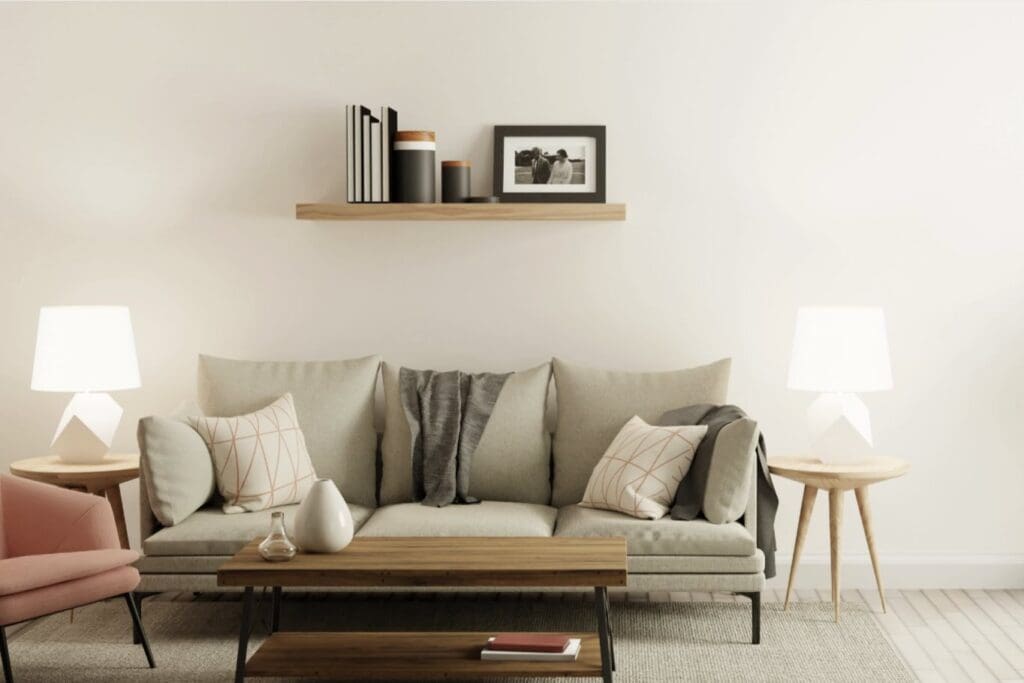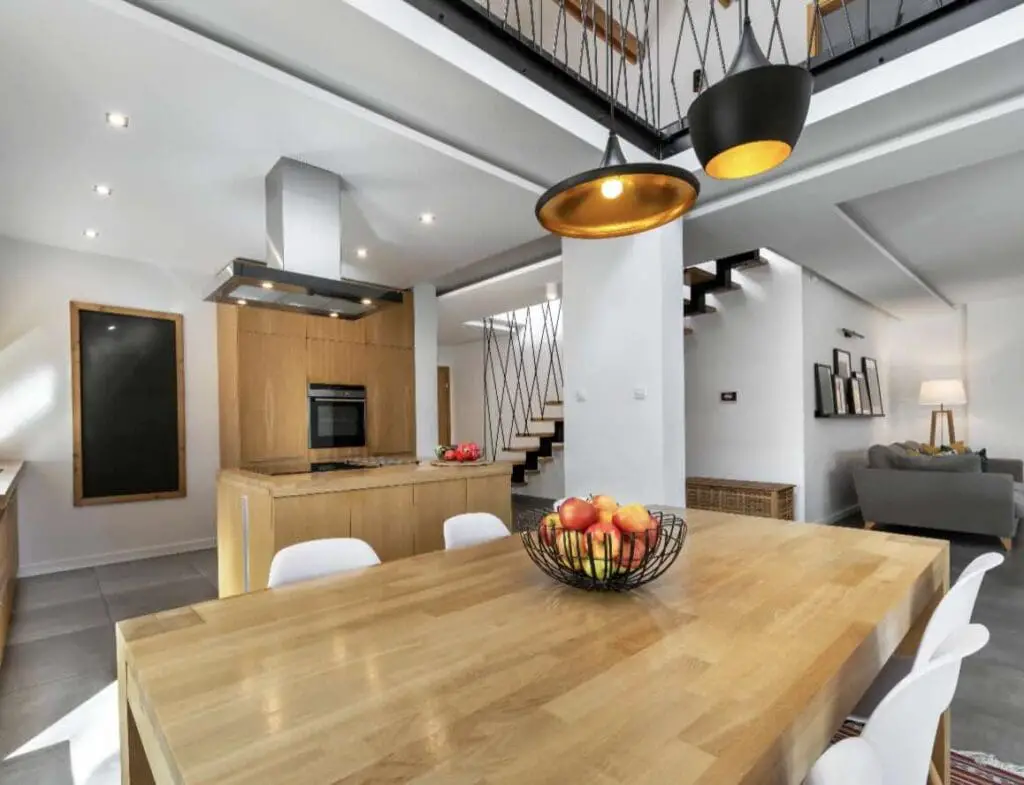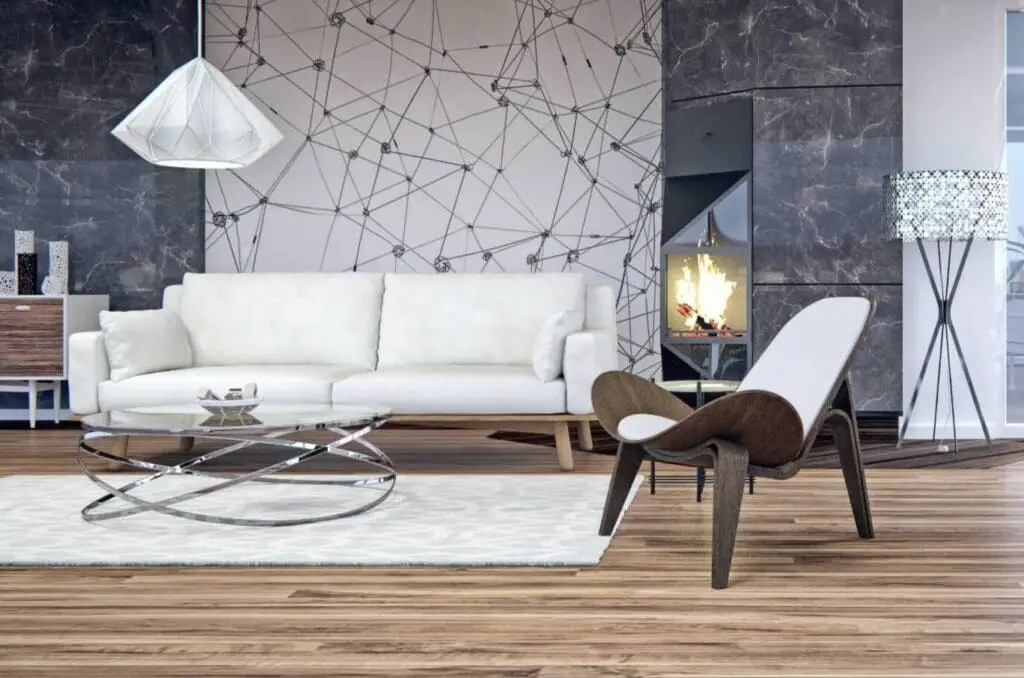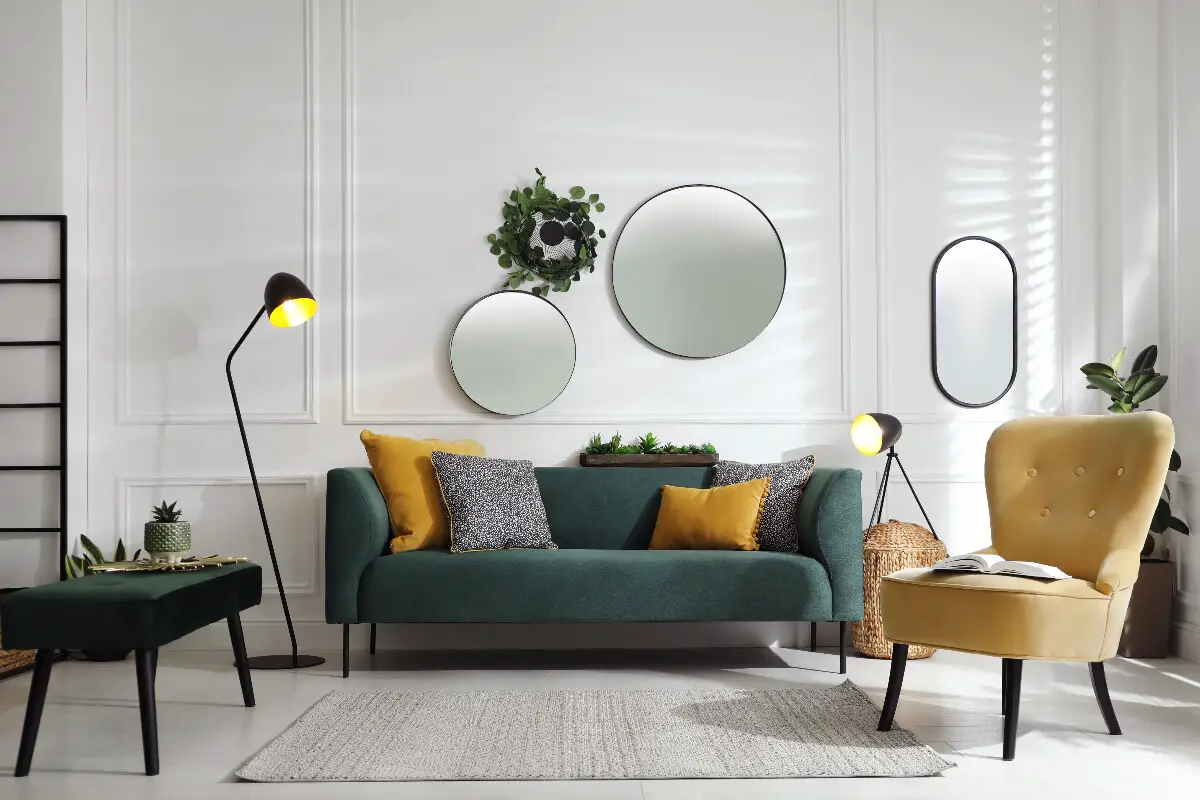Delving into modern house interior design unveils a rich tapestry of aesthetic choices and intelligent, functional living spaces. Color, the very lifeblood of visual harmony, plays a pivotal role in creating the ambiance of a home, leaving an indelible impact on mood and spatial perception.
Alongside hue, the thoughtful selection of furniture stands as a cornerstone, reflecting a blend of minimalism and utility that is the hallmark of modernity. Illumination in these spaces is no mere utility; it is an artistic statement, a dance of shadows and light that can redefine every corner.
Table of Contents
- The Color Palette of Modern Homes
- Furniture Selection for Modern Spaces
- Lighting as an Artistic Statement
- Incorporating Technology into Design
- Textiles and Textures in Modern Homes
- Related Content
The Color Palette of Modern Homes
The Harmonious Palette: Influencing Mood with Color in Modern Homes
In modern interior design, color is far more than just a backdrop; it’s an essential component that can dramatically alter the mood of a home. Understanding its power can transform everyday living spaces into bastions of comfort, energy, and inspiration.
Visualize entering a room bathed in soft blues and calming greens. These hues whisper tranquility, crafting an oasis of peace that soothes the soul—a perfect setting for unwinding after a long day. Blue’s association with the sky and water lend a subconscious nod to vastness and serenity, while green, the color of nature, promotes balance and renewal.
Shift to a different space, where vibrant yellows and bold oranges ignite the atmosphere. These warm tones exude happiness and enthusiasm, stimulating lively conversations and creative thought. Yellow, reminiscent of sunshine, infuses a room with brightness and warmth, perfect for stimulating morning routines. With its playful and energetic vibe, Orange sparks social interactions, making it ideal for dining areas where people gather.
Modern homes often employ a neutral canvas; stark whites, soft grays, and earthy browns set the stage for minimalist elegance. These shades serve as a versatile foundation, allowing for mood fluctuations through accent colors. A stark charcoal accent wall can introduce drama and sophistication, while creamy whites create an aura of purity and simplicity, rendering a home spacious and airy.
Deep purples and rich wines lend an air of luxury and creativity. Used judiciously in a modern setting, these colors add a layer of luxury without overwhelming the senses. An eggplant-hued throw pillow or a merlot accent piece can deliver that touch of royal elegance that elevates a room’s character.
The muted tones of Scandinavian-inspired interiors reflect a pristine, uncluttered mindset, which promotes a sense of order and mental clarity. Think powdery pastels and unsaturated colors that invite softness into the home, complementing the natural light and making the space feel larger and more open.
Texture and material support this color-led performance, with glossy finishes reflecting light and bringing dynamism to the chosen hues. At the same time, mattes absorb light, lending a subdued and earthy quality. Incorporating various textures can subtly alter the mood without the need for stark color changes.
In experimenting with color to influence the mood of a modern home, consider the room’s function, the time spent within, and the emotions desired to be evoked. Play with swatches and samples, envisioning how the sun’s changing light will dance with the chosen palette.
Through the strategic use of color, a modern home becomes an extension of one’s internal landscape—a canvas where daily life is enriched by the hues selected with intention and care. Just as a painter wields their brush to evoke emotion on canvas, so too can a dweller curate their surroundings to reflect, invigorate, and soothe through the spectrum of color.

Furniture Selection for Modern Spaces
In modern interior design, furniture’s shape, simplicity, and functional beauty play pivotal roles. Beyond the rich tapestry of color, furniture pieces anchor a space, defining the aesthetic and the soul of contemporary living.
At the forefront of modern design is the minimalist sofa. Characterized by clean lines, simple forms, and often low profiles, these sofas prioritize comfort without sacrificing style.
They serve as the primary gathering point in a living space, complementing the color stories woven into the surroundings. As functional statement pieces, they blend seamlessly into the modern home while supporting the vibrant social hub or tranquil retreat crafted through color selections.
The coffee table has evolved from a mere surface to an expression of artistic sensibility. Modern iterations are often sleek and geometric, doubling as sculptural centerpieces that reflect the room’s overall vibe. Whether it’s glass, polished wood, or metal, the modern coffee table interacts with the tones and textures previously established, tying together the visual poetry of the space.
Iconic to modern design is the modular shelving unit. These versatile structures offer practical storage and form dynamic displays like living art. With an emphasis on negative space and the play of light and shadow, they allow items to float, providing a platform for bold colors and personal treasures to shine.
Furthermore, the dining chair has become a canvas for modern designers to combine functionality with unabashed creativity. From wireframe models that complement airy and light-filled rooms to solid, sculptural forms that anchor and balance the buzzy brights of a dining area, these chairs communicate the ethos of modern design and immerse diners in the intended mood.
The transformative bed frame in modern bedrooms is often low to the ground and embodies the principle of ‘less is more.’ It’s a silent proclamation of rest and rejuvenation—unadorned yet striking, inviting a contrast between the vibrant linens and the serene walls.
Lastly, accent lighting fixtures, whether floor lamps, pendants, or sconces, serve as the home’s jewelry—completing the ensemble with a sparkle or a subtle glow. They are the final touch that enhances the selected hues, casting light and creating an ambiance that reflects off surfaces and colors to give the space its final, magical touch.
Modern furniture is more than the sum of its parts; it is a symphony of form, function, and color. Each piece complements the canvas of the modern interior, ensuring that each color selected and every texture introduced is not just seen but genuinely experienced. In this way, modern furniture is not just a statement of fashion but a living embodiment of form meeting function in the most aesthetically pleasing way.

Lighting as an Artistic Statement
Illuminating Artistry: Balancing Function with Aesthetic in Modern Home Lighting
In modern home design, lighting transcends its primary duty of illumination to become a pivotal component of artistic expression. Just as musical notes compose a symphony, lighting designs orchestrate an ambiance that can elevate the soul of a space to a piece of living art.
Thoughtful lighting design not only brightens areas but also shapes mood, delineates space, and spotlights the artistic elements within a home. By exploring the harmony between the functional and the aesthetic, lighting becomes an element that serves a purpose and delights the senses.
Consider using ambient lighting to create a soft, diffuse glow, gently bathing a room in light that can enhance feelings of warmth and welcome. Deftly integrated, ambient lighting enlivens the colors and furniture, lending vitality to static surroundings.
Task lighting, on the other hand, is the workhorse of lighting design—focused and direct, yet it can exhibit an artistic form. Sleek, modern desk lamps or under-cabinet kitchen lights blend practicality with the clean lines and metallic finishes cherished in contemporary aesthetics.
Accent lighting is where one may fully indulge in artistic flair, directing beams to highlight artworks, architectural features, or focal points. This type of lighting partners with shadows to give volume and drama to an area, making every highlighted object a visual poem.
Furthermore, the materials used in lighting fixtures weave a narrative of their own. Industrial metals speak to urban-chic opulence; woods tell tales of organic warmth, and glass fixtures cast prismatic reflections akin to modern stained glass vignettes.
Technology, too, plays a vital role in the modern alchemy of light. LED lighting options offer a palette of hues, enabling homeowners to shift the mood of their spaces with the touch of a button. Smart home integrations allow these changes to correspond with one’s daily rhythms, immersing inhabitants in a perfectly timed, visually dynamic environment.
The design of the lighting fixture itself is a sculptural opportunity—an object that, even when unlit, captivates as a centerpiece. Sputnik chandeliers, arcing floor lamps, and minimalist pendant lights are fixtures that marry utility with undeniable artistry.
From spotlighting precious moments to illuminating tasks, the application of lighting in modern homes is multifaceted. When embraced as a vehicle for aesthetic beauty, lighting installations can narrate a visual tale as personalized and vibrant as the brush strokes on a canvas.
Creating well-lit spaces and brimming with artistic intent is a balancing act of choice and placement. Whether seeking to inspire creativity, instill calm, or invigorate with energy, the thoughtful integration of lighting within a modern home is equivalent to giving voice to an invisible muse, guiding the ambiance and elevating each moment spent within its embrace.

Incorporating Technology into Design
Embracing the Digital Canvas: Seamless Technological Integration in Modern House Design
In the quest for a harmonious abode where form meets function, the contemporary artist does not shy away from the digital age. Modern house design is more than a display of the latest gadgets; it is about weaving technology into the very fabric of our living spaces. Here’s how technology can integrate seamlessly into the sanctuary of tomorrow.
Firstly, smart home systems are the epitome of functional artistry. Picture this: a canvas where lighting, temperature, and security are not just facets of a structure but strokes of a master’s brush controlled with the lightest touch or even a gentle spoken word.
Programmable thermostats learn your schedule, adjusting the ambient temperature for comfort and energy efficiency—a true muse for the environmentally conscious creator.
Next, Home automation platforms allow for the curation of daily scenes. As an artist selects hues for their palette, residents may select settings for various home scenes—dinner party, movie night, or peaceful slumber—with lighting and multimedia components adjusting in concert. Through this orchestration, homes become a living gallery, dynamic and responsive to the inhabitants’ needs.
Large, open spaces with expansive windows lend themselves to artistic expression in the dance of light and shadow. Motorized window treatments offer an impactful connection with natural light, inviting the sun to paint its warmth across the interior. Coupled with light sensors, blinds, and curtains adjust to the time of day, ensuring the play of light remains a tireless living sculpture.
Sound is the invisible painter of ambiance, and integrated audio systems distribute harmonious melodies through discreetly placed speakers, often indistinguishable from the decor.
With multi-room audio, the composition flows seamlessly from one space to another, crafting an auditory masterpiece that complements the visual feast within the home’s walls.
The modern creator understands that the kitchen is part gallery, part workshop. High-end, connected appliances serve as the sous-chef for culinary endeavors, smart fridges catalog the contents, and recipe suggestions appear on integrated screens, transforming meal prep into an interactive art form.
For the connoisseur of convenience, voice-activated assistants and touch-activated surfaces are akin to assistants for the modern maestro. Imagine dictating a grocery list to a home assistant or tapping a countertop to display a recipe; technology takes on an almost magical quality, creating an atmosphere where the mundane is draped in the wondrous.
Finally, incorporating eco-friendly, sustainably designed technology reflects the modern artist’s consciousness of their broader canvas—the Earth.
Solar panels integrating seamlessly into roofing and intelligent water systems managing consumption are just two examples where technology, design, and eco-awareness meld to fashion a statement as strong as any visual composition.
The seamless integration of technology in modern house design extends far beyond utility—it is an evolution of living spaces into immersive, interactive art installations, where every corner offers a dialogue with the digital age without losing the essence of home.

Textiles and Textures in Modern Homes
Weaving Warmth into Modern Spaces: The Artistry of Textiles in Contemporary Decor
As one steps across the threshold of a modern interior, the immediate senses are greeted with an array of visual and tactile stimuli. The living space is not merely a scene to behold but an immersive experience, and herein lies the magic of textiles. Beyond mere fabric, textiles are the unsung heroes, imbuing modern interiors with warmth, depth, and a whisper of life’s comforts.
Textiles serve as the harmonious bridge linking all elements of interior design. While furniture outlines the room’s silhouette, textiles gift it a soul. Drapes cascade like waterfalls, diffusing the sunlight to a tender glow, while throws, tactically draped over the edge of a sofa, invite one to curl up in a cozy embrace.
Modern interiors often bask in minimalism’s beauty, where the seduction of space plays a pivotal role; it is here that textiles dance, adorning without overwhelming.
Consider the intimacy of pillows nestling on a sleek contemporary couch. Their presence, while quiet, punctuates the home with an understated elegance. Textiles may carry bold geometric shapes, invite with velvety textures, or add a playful dimension with tassels and fringes.
The gentle juxtaposition of a softly knit pouf against the clean lines of a metal-legged chair introduces a visual dialogue of contrast, flirtation, and, ultimately, balance.
Rugs lay the foundation of warmth upon which modern interiors stand. Whether they flaunt monochromatic hues or abstract expressions, rugs ground the furniture’s conversation and cushion the feet’s tales.
Modern interiors often boast hard surfaces like wood, concrete, or tile; adding a rug can diminish echoes, crafting a sonnet of quietude where footsteps once clamored.
In modern bedrooms, textiles proclaim their dominance in the sanctuary’s embrace. Bed linens, from smooth Egyptian cotton to eco-friendly bamboo fibers, beckon with the promise of restful slumbers. The bed is a gallery display, and the linens are the artwork—every fold, every crease, a stroke of the designer’s intent.
The function of textiles extends into realms of privacy and modulation. Room dividers can exude bold character or whispered subtlety, defining spaces without erecting walls. They can play with light, allow airflow, and shift with the room’s needs—dynamic and adaptable art pieces.
In the theater of modern interiors, textiles play a versatile role. They can be the lead, commanding attention with vibrant patterns set against stark walls, or the supporting act, bringing others to prominence through their gentle solidarity of color and texture. Through their fluidity and grace, textiles skirt the line between function and finery, elevating the simple act of living to an art form that colors, shapes, and defines the heart of any space.
The strategic use of textiles is a study of sensory alchemy. From the hushed whisper of sheer curtains to the robust exclamation of a woven tapestry, textiles articulate the unspoken desires for comfort and beauty. In this modern play of interiors, textiles are the silent narrators, enveloping everyday life with a richness that sings a story of home.
Textures and textiles imbue these environments with warmth and tactile satisfaction, countering the sleek lines of contemporary design. At the same time, carefully curated art becomes the voice of personal expression within the architectural canvas.
The alchemy of these components is where modern interior design finds its footing, offering a habitat that is not just reflective of the times but anticipates the evolution of our notion of ‘home.
Find out more about how Mondoro can help you create, develop, and manufacture excellent home decor and furniture products – don’t hesitate to contact me, Anita. Check out my email by clicking here or become a part of our community and join our newsletter by clicking here.
Mondoro gives out a FREE Lookbook to anyone interested. You can receive a copy of our latest Lookbook by clicking here.
Listen to our Podcast called Global Trade Gal. You can find it on all major podcast platforms. Try out listening to one of our podcasts by clicking here.
Subscribe to our Mondoro Company Limited YouTube Channel with great videos and information by clicking here.
Related Content
What Is The Mother Of Pearl Shell Used In Home Decor Products?
Mother of pearl, also known by the scientific name of nacre, is a pearl layer on the inner layer of the oyster shell. This pearl layer of the oyster is taken off the outer oyster shell. Then the leftover inner pearl shell is cut into various small shapes and sizes to be glued onto multiple home decor products such as mirrors, boxes, trays, and lamp bases.
You can read our blog on What Is The Mother Of Pearl Shell Used In Home Decor Products? by clicking here.
How Do You Make A Bamboo Lamp Shade? All About Bamboo Lampshades
To manufacture or make bamboo lampshades, you need to 1) properly prepare the bamboo materials, 2) build a metal frame, 3) wrap the metal frame, 4) secure the bamboo onto the metal frame, 5) spray color on top of the bamboo shade if you desire the lampshade to be a color other than natural and 6) spray a top coat on the entire shade to protect the bamboo shade’s finish.
You can read our blog about How Do You Make A Bamboo Lamp Shade? All About Bamboo Lampshades by clicking here.
What Is The Modern Farmhouse Interior Design Style?
The modern farmhouse interior design style has become increasingly popular as people look to create a warm and inviting home that reflects a more straightforward, rustic way of life. Combining classic farmhouse elements with contemporary design touches, this style blends the old and the new to create a comfortable and stylish living space.
You can discover more by reading What Is The Modern Farmhouse Interior Design Style?, by clicking here.


